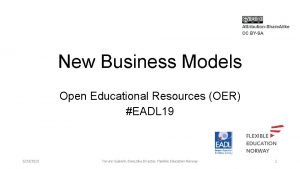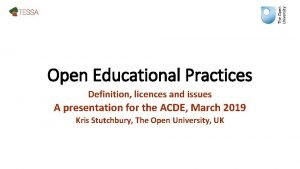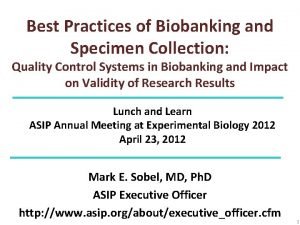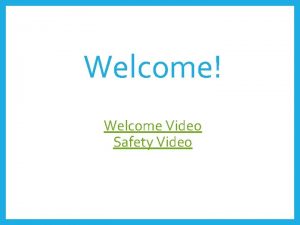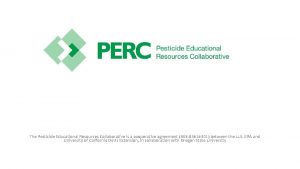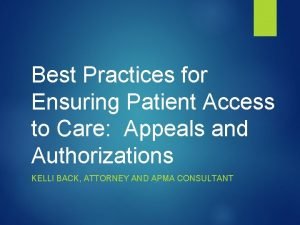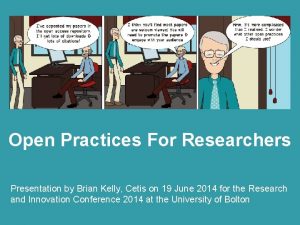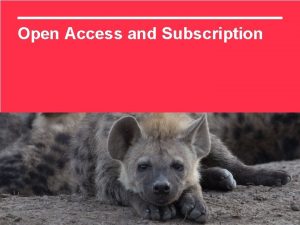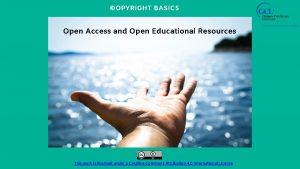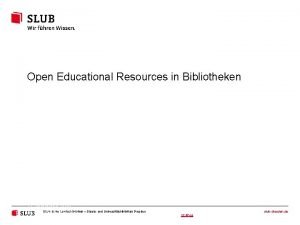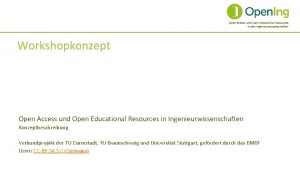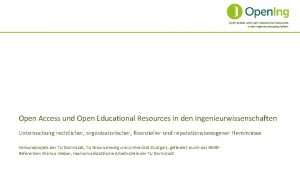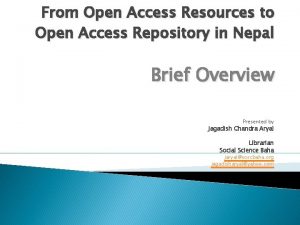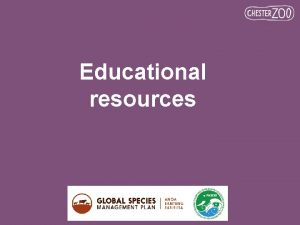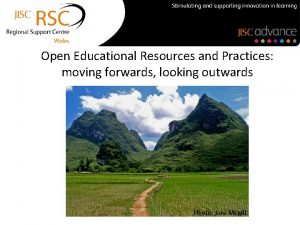Open Educational Resources Open Access and Open Practices











- Slides: 11

Open Educational Resources, Open Access, and Open Practices August 2020 Creative Commons Certificate Course Constance Blomgren

Overview • What are Open Educational Resources (OER)? • What is Open Access (OA)? • How are these two aspects of openness related? • How does OER and OA influence Open Practices?

Open Educational Resources • “Open Educational Resources (OER) are teaching, learning and research materials in any medium – digital or otherwise – that reside in the public domain or have been released under an open license that permits no-cost access, use, adaptation and redistribution by others with no or limited restrictions. • OER form part of ‘Open Solutions’, alongside Free and Open Source software (FOSS), Open Access (OA), Open Data (OD) and crowdsourcing platforms. ” UNESCO (2019), para 1.

Open Access “Open Access means free access to scientific information and unrestricted use of electronic data for everyone. With Open Access, expensive prices and copyrights will no longer be obstacles to the dissemination of knowledge. Everyone is free to add information, modify contents, translate texts into other languages, and disseminate an entire electronic publication. ” [emphasis added] UNESCO, (2019), Para 1.

OER & OA

Benefits of Open Access Faculty & Students • Wider (i. e. global) and quicker research dissemination. • Because there is no journal publisher paywall, more people can access and use scholarly research. • Published research feeds new ideas and research; OA nurtures the search for new information and knowledge. • Research indicates that the global OA leads to more citations and knowledge sharing. • OA supports the knowledge economy, provides an economic boost, and businesses of all sizes have access to the newest scientific research and ideas. • OA supports wider reuse; the most recent OA knowledge can immediately support students and faculty as part of OER. Open Access NL (2020)

Challenges for Open Access • High impact factor journals influence the competitive ratings of researchers; it takes time for any journal (OA or other) to establish a high impact factor. Because of OA, rating researchers is being reconsidered. • OA journals vary substantially by discipline, both in quality and number. • OA may involve additional administration, knowledge of copyright, and Creative Commons licenses. Researchers need to learn about CC licenses so that they can, in turn influence undergraduate and graduate student knowledge about OA. • Author Processing Charges (APCs) for OA may be an additional financial cost for researchers. • Predatory “OA” journals may spam researchers, and this negatively influences support for the OA publication model. These databases score verified OA journals: QOAM, Scirev. sc and DOAJ. • Repositories require publication data and the full text of articles which becomes extra work for authors. • Texts in a repository may encounter copyright barriers if publishing with open access. Consequently, researchers may hesitate about repositories and OA. Open Access NL (2020)

OA does NOT mean • as the author, you relinquish copyright; • the publication will be published without peer review; • the journal will not be included in scholarly databases; • the publication will not have an impact factor. Open Access NL (2020) para 3

OER + OA = Open Educational Practices (OEP) OEP Cronin (2017), p. 4 Critical digital pedagogy Open scholarship Networked participatory scholarship Open teaching

OEP • “…moving beyond a content-centred approach, shifting the focus from resources to practices, with learners and teachers [researchers] sharing the processes of knowledge creation” • Cronin (2017), p. 3.

References Cronin, C. (2017). Openness and Praxis: Exploring the Use of Open Educational Practices in Higher Education. The International Review of Research in Open and Distributed Learning, 18(5). https: //doi. org/10. 19173/irrodl. v 18 i 5. 3096 Open Access NL (2020). What is Open Access? Pros and Cons [webpage]. https: //www. openaccess. nl/en/what-is-open-access/pros-and-cons. UNESCO (2019), An open door to UNESCO's knowledge [webpage]. https: //en. unesco. org/open-access/ UNESCO (2019), Open Educational Resources (OER), [webpage]. https: //en. unesco. org/themes/building-knowledge-societies/oer
 Open educational resources
Open educational resources Educational practices definition
Educational practices definition Operations transformation process
Operations transformation process Variable resources definition
Variable resources definition Nci best practices for biospecimen resources
Nci best practices for biospecimen resources Ckla grade 5 unit 1 personal narratives
Ckla grade 5 unit 1 personal narratives Pesticide educational resources collaborative
Pesticide educational resources collaborative Patient access best practices
Patient access best practices Renewable resources vs nonrenewable resources
Renewable resources vs nonrenewable resources Terminal access controller access control system plus
Terminal access controller access control system plus Terminal access controller access-control system
Terminal access controller access-control system 영국 beis
영국 beis
